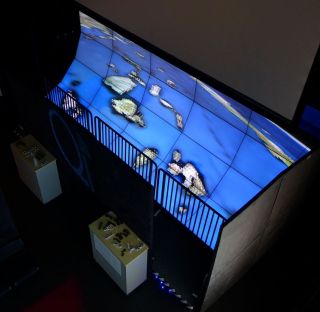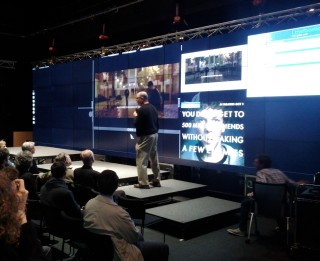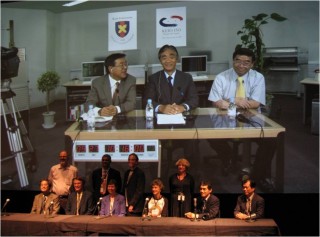Difference between revisions of "Infrastructure"
(→Digital Theater) |
|||
| (73 intermediate revisions by 2 users not shown) | |||
| Line 1: | Line 1: | ||
| − | === | + | ===WAVE=== |
| − | <table> | + | <table border=1> |
<tr> | <tr> | ||
| − | <td>[[Image: | + | <td valign="top">[[Image: WAVE-320.jpg]]</td> |
| − | <td valign="top">The | + | <td valign="top"> |
| − | + | The WAVE is located in the SME building. By mounting the screens in a cylindrical shape, we minimize ghosting issues with them. And by mounting them horizontally, we allow for more viewers to see images without ghosting. | |
| − | + | ||
| − | + | ||
| − | + | The WAVE consists of 35 3DTVs from LG with a 55" diagonal and narrow bezels. The displays support passive stereo with circular polarization at full HD resolution. The system displays about 35 million pixels per eye. It is powered by 19 graphics PCs with dual Nvidia GeForce GTX 780 graphics cards. We use an optical tracking system and input device from [http://www.ar-tracking.com AR Tracking]. | |
| − | + | ||
| − | + | ||
| − | + | ||
| − | + | ||
</td> | </td> | ||
</tr> | </tr> | ||
</table> | </table> | ||
| − | + | ===The Big Wall in the Vroom=== | |
| − | === | + | <table border=1> |
| − | + | ||
| − | + | ||
| − | <table> | + | |
<tr> | <tr> | ||
| − | <td>[[Image: | + | <td valign="top">[[Image: Vroom.jpg]]</td> |
| − | <td valign="top"> | + | <td valign="top"> |
| + | Located in Atkinson Hall, the Big Wall in the Vroom (Virtual Room) is a tiled display environment with four rows of eight displays for a total of 32 narrow-bezel NEC X551UN LCD displays with a 55" screen diagonal. Each of the displays has full HD resolution (1920x1080 pixels), adding up to 66 million pixels on the entire wall (15,360 x 4,320 pixels). We also support multi-channel audio, and use a four-camera optical tracking system from [http://www.vicon.com/ Vicon]. All displays have been attached in 2x2 patterns to mounting structures, which are either installed in movable containers (OptiPortables) or suspended from above. The displays in the Big Wall are driven by 16 rendering PCs running CentOS Linux, each with dual Nvidia Geforce 580 graphics cards. Additionally, there are three separate control PCs (head nodes), each of them set up for one of the three supported software environments: [http://vis.ucsd.edu/~cglx/ CGLX], [http://ivl.calit2.net/wiki/index.php/CalVR CalVR] and [http://www.evl.uic.edu/core.php?mod=4&type=1&indi=281 SAGE]. | ||
</td> | </td> | ||
</tr> | </tr> | ||
</table> | </table> | ||
| − | === | + | ===Auditorium=== |
| − | <table> | + | <table border=1> |
<tr> | <tr> | ||
<td valign="top">[[Image: telepresence-320.jpg]]</td> | <td valign="top">[[Image: telepresence-320.jpg]]</td> | ||
| − | <td valign="top"> | + | <td valign="top">Qualcomm Institute's digital theater auditorium offers 200 seats with power and Ethernet jacks in every seat. The high end technical equipment installed in this room allows it to be used for anything ranging from presentations with Powerpoint slides, video screenings, presentations of visual and performance art, to demonstrations of the future of digital cinema: 4k video on a 18 by 32 foot screen. Among the technical highlights of the auditorium are: a 20 channel surround sound system, high definition (HD) video playback from computers or digital HD tapes, real-time virtual reality with a 3D tracking system, and a [http://www.sony.com/sxrd/ Sony SRXD-R110] 4k projector (4096x2160 pixels resolution). The control room houses the following 4k-relevant hardware: |
* An NTT hardware codec, which can play back JPEG2000 compressed 4k video with multi-channel audio at 24 or 30 frames per second. | * An NTT hardware codec, which can play back JPEG2000 compressed 4k video with multi-channel audio at 24 or 30 frames per second. | ||
* A [http://www.zaxel.com Zaxel] video server with lossless compression to playback and record 4k video. | * A [http://www.zaxel.com Zaxel] video server with lossless compression to playback and record 4k video. | ||
| − | |||
Other equipment used in the digital theater includes a digital light mixer, a conventional projector by [http://www.christiedigital.com Christie] with a resolution of 1600x1200 pixels, and a remote control system by [http://www.crestron.com Crestron] which allows presenters to connect their laptops and control video and audio directly from the podium. | Other equipment used in the digital theater includes a digital light mixer, a conventional projector by [http://www.christiedigital.com Christie] with a resolution of 1600x1200 pixels, and a remote control system by [http://www.crestron.com Crestron] which allows presenters to connect their laptops and control video and audio directly from the podium. | ||
Latest revision as of 22:09, 9 September 2021
WAVE
 |
The WAVE is located in the SME building. By mounting the screens in a cylindrical shape, we minimize ghosting issues with them. And by mounting them horizontally, we allow for more viewers to see images without ghosting. The WAVE consists of 35 3DTVs from LG with a 55" diagonal and narrow bezels. The displays support passive stereo with circular polarization at full HD resolution. The system displays about 35 million pixels per eye. It is powered by 19 graphics PCs with dual Nvidia GeForce GTX 780 graphics cards. We use an optical tracking system and input device from AR Tracking. |
The Big Wall in the Vroom
 |
Located in Atkinson Hall, the Big Wall in the Vroom (Virtual Room) is a tiled display environment with four rows of eight displays for a total of 32 narrow-bezel NEC X551UN LCD displays with a 55" screen diagonal. Each of the displays has full HD resolution (1920x1080 pixels), adding up to 66 million pixels on the entire wall (15,360 x 4,320 pixels). We also support multi-channel audio, and use a four-camera optical tracking system from Vicon. All displays have been attached in 2x2 patterns to mounting structures, which are either installed in movable containers (OptiPortables) or suspended from above. The displays in the Big Wall are driven by 16 rendering PCs running CentOS Linux, each with dual Nvidia Geforce 580 graphics cards. Additionally, there are three separate control PCs (head nodes), each of them set up for one of the three supported software environments: CGLX, CalVR and SAGE. |
Auditorium
 |
Qualcomm Institute's digital theater auditorium offers 200 seats with power and Ethernet jacks in every seat. The high end technical equipment installed in this room allows it to be used for anything ranging from presentations with Powerpoint slides, video screenings, presentations of visual and performance art, to demonstrations of the future of digital cinema: 4k video on a 18 by 32 foot screen. Among the technical highlights of the auditorium are: a 20 channel surround sound system, high definition (HD) video playback from computers or digital HD tapes, real-time virtual reality with a 3D tracking system, and a Sony SRXD-R110 4k projector (4096x2160 pixels resolution). The control room houses the following 4k-relevant hardware:
Other equipment used in the digital theater includes a digital light mixer, a conventional projector by Christie with a resolution of 1600x1200 pixels, and a remote control system by Crestron which allows presenters to connect their laptops and control video and audio directly from the podium. |